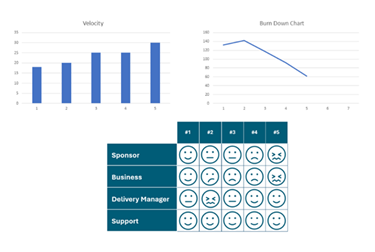PMI-ACP Practice Questions #111
You are working on an e-commerce product development project with 7 iterations planned before the release goes live for customers. As the team progresses, you have access to key performance indicators such as velocity trends, a burndown chart, and stakeholder sentiment (Niko-Niko calendar) to assess the project’s health.

Given the current project status, what actions should you consider to ensure a successful product launch?
A. Maintain the current pace and ensure that committed user stories are completed as planned.
B. Engage with business stakeholders and sponsors to understand concerns and align expectations for the remaining iterations.
C. Push the team to increase their velocity further to ensure faster delivery.
D. Work with stakeholders to ensure no new work gets added in the release since we are just two sprints
Analysis
In this scenario, the team is developing an e-commerce product with a planned 7-iteration release cycle. The key performance indicators available include:
- Velocity trends, which show a stable or improving pace of delivery.
- Burndown chart, which indicates good progress despite a minor increase in work during iteration 2.
- Niko-Niko calendar, which reflects growing dissatisfaction among business stakeholders and sponsors, while the delivery manager and support team remain satisfied.
The main concern here is the stakeholder sentiment (business and sponsors becoming unhappy). Although velocity and burndown indicate good progress, ignoring stakeholder dissatisfaction can result in a failed product launch due to misalignment between business needs and development progress.
The best course of action should address these concerns without disrupting the positive delivery trends.
Analysis of Options
A: Maintain the current pace and ensure that committed user stories are completed as planned.
While maintaining delivery focus is important, this option ignores the declining stakeholder sentiment. The business and sponsors are concerned about something, and simply continuing the plan without engaging them may lead to unmet business expectations, resulting in a failed product launch. This option fails to address the key issue highlighted by the Niko-Niko calendar and is not the best choice.
B: Engage with business stakeholders and sponsors to understand concerns and align expectations for the remaining iterations.
This is the best option because it directly addresses the dissatisfaction of key stakeholders (business and sponsors).
- Since delivery metrics (velocity and burndown) are on track, the main risk is business misalignment rather than execution delays.
- Engaging stakeholders ensures that their expectations align with development progress, avoiding last-minute surprises or dissatisfaction upon release.
- This aligns with Agile principles of continuous feedback and adaptation rather than blindly following an initial plan.
C: Push the team to increase their velocity further to ensure faster delivery.
This option assumes that speed is the issue, but the burndown chart and velocity trends indicate that delivery is progressing well.
- Forcing the team to work faster may lead to burnout or quality issues without addressing the real concern (stakeholder dissatisfaction).
- Since business stakeholders and sponsors are not unhappy due to slow delivery, increasing velocity does not solve the problem.
D: Work with stakeholders to ensure no new work gets added in the release since we are just two sprints away.
While controlling scope creep is important, this approach may further alienate stakeholders by shutting them out of the process.
- If stakeholders are already dissatisfied, rigidly enforcing the current plan without understanding their concerns will likely make things worse.
- The focus should be on engaging stakeholders and aligning expectations, not just blocking changes.
Conclusion
The best approach is Option B: Engage with business stakeholders and sponsors to understand concerns and align expectations for the remaining iterations.
This solution ensures that:
- Stakeholders’ concerns are addressed proactively, reducing the risk of dissatisfaction at launch.
- The team continues delivering at a steady, predictable pace, without unnecessary pressure to increase velocity.
- Future iterations align better with business needs, making the final product more valuable.
This aligns with Agile principles of stakeholder collaboration, continuous feedback, and adaptive planning, ensuring a successful and well-received product launch.
PMI – ACP Exam Content Outline Mapping
| Domain | Task |
| Delivery | Manage Agile Metrics |
Topics Covered:
- Monitoring stakeholder sentiment alongside delivery metrics
- Balancing delivery pace with business alignment
- Using feedback tools (e.g., Niko-Niko calendar) to assess project health
- Engaging stakeholders proactively to align expectations
- Applying Agile principles of collaboration, feedback, and adaptation
- Managing progress using velocity trends and burndown charts
- Prioritizing stakeholder satisfaction for a successful product launch
If you’re preparing for the PMI Agile Certified Practitioner (PMI-ACP)® Exam, we highly recommend enrolling in our PMI-ACP® Exam Prep Program. Designed to provide a comprehensive Agile learning experience, this program not only helps you ace the PMI-ACP® exam but also enhances your Agile mindset, leadership skills, and ability to deliver value-driven projects. Ensure exam success and career growth with our expert-led, structured preparation program tailored for Agile professionals.